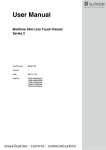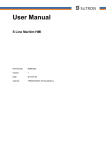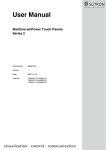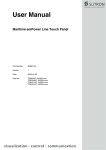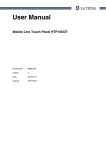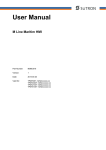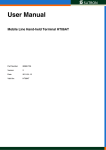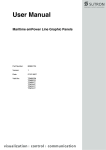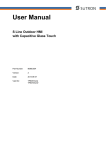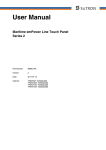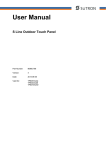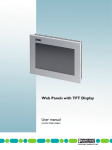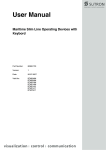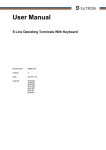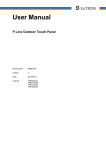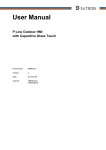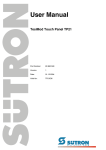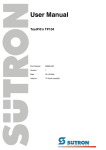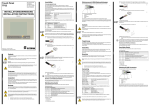Download User Manual Maritime Slim Line Touch Panels
Transcript
User Manual Maritime Slim Line Touch Panels Part Number: 80860.732 Version: 2 Date: 2010-12-01 Valid for: TPM11AM TPM11AT TPM21AM TPM21AS TPM21AT TPM35AM TPM35AT TPM43AT TPM57AM TPM57AT TPM70AT TPM90AT TPM104AT TPM105AT TPM120AT TPM151AT Version 1 2 Date 2007-09-14 2010-12-01 Modifications First Edition Upgrade devices: TPM35AM, TPM35AT, TPM43AT, TPM57AM, TPM57AT, TPM90AT, TPM105AT, TPM120AT, TPM151AT This manual, including all illustrations contained herein, is copyright protected. Use of this manual by any third party in departure from the copyright provision is forbidden. No part of this manual may be reproduced, translated or electronically or photographically archived or altered without the express written consent from Sütron electronic GmbH. Violations shall be cause for damage liability. Sütron electronic reserves the right to make any changes that contribute to technical improvement. Overall Table of Contents Overall Table of Contents 1 2 Important Notes ....................................................................................................... 1-1 1.1 Symbols .................................................................................................... 1-1 1.2 Safety Notes ............................................................................................. 1-1 1.3 Intended Use............................................................................................. 1-2 1.4 Target Group............................................................................................. 1-2 Installation and Commissioning ............................................................................... 2-1 2.1 Unpacking the Device ............................................................................... 2-1 2.2 Mounting the Device ................................................................................. 2-1 2.2.1 Front Panel Dimensions ...................................................................... 2-2 2.2.1.1 TPM11AM, TPM11AT.................................................................................................2-2 2.2.1.2 TPM21AM, TPM21AS, TPM21AT ..............................................................................2-2 2.2.1.3 TPM35AM, TPM35AT.................................................................................................2-3 2.2.1.4 TPM43AT....................................................................................................................2-3 2.2.1.5 TPM57AM, TPM57AT.................................................................................................2-4 2.2.1.6 TPM70AT....................................................................................................................2-5 2.2.1.7 TPM90AT....................................................................................................................2-6 2.2.1.8 TPM104AT..................................................................................................................2-7 2.2.1.9 TPM105AT..................................................................................................................2-8 2.2.1.10 TPM120AT..................................................................................................................2-9 2.2.1.11 TPM151AT................................................................................................................2-10 2.2.2 Mounting Cutout ................................................................................ 2-11 2.2.2.1 TPM11AM, TPM11AT...............................................................................................2-11 2.2.2.2 TPM21AM, TPM21AS, TPM21AT ............................................................................2-12 2.2.2.3 TPM35AM, TPM35AT...............................................................................................2-13 2.2.2.4 TPM43AT..................................................................................................................2-14 2.2.2.5 TPM57AM, TPM57AT...............................................................................................2-15 2.2.2.6 TPM70AT..................................................................................................................2-16 2.2.2.7 TPM90AT..................................................................................................................2-17 2.2.2.8 TPM104AT................................................................................................................2-18 2.2.2.9 TPM105AT................................................................................................................2-19 2.2.2.10 TPM120AT................................................................................................................2-20 2.2.2.11 TPM151AT................................................................................................................2-21 2.2.3 Side View, Mounting Depth ............................................................... 2-22 2.2.3.1 TPM11AM, TPM11AT...............................................................................................2-22 2.2.3.2 TPM21AM, TPM21AS, TPM21AT ............................................................................2-23 2.2.3.3 TPM35AM, TPM35AT...............................................................................................2-24 2.2.3.4 TPM43AT..................................................................................................................2-25 2.2.3.5 TPM57AM, TPM57AT...............................................................................................2-26 2.2.3.6 TPM70AT..................................................................................................................2-27 2.2.3.7 TPM90AT..................................................................................................................2-28 2.2.3.8 TPM104AT................................................................................................................2-29 2.2.3.9 TPM105AT................................................................................................................2-30 2.2.3.10 TPM120AT................................................................................................................2-31 2.2.3.11 TPM151AT................................................................................................................2-32 2.3 2.3.1 Connecting the Device............................................................................ 2-33 Supply Voltage................................................................................... 2-33 i Overall Table of Contents 2.4 2.4.1 Loading Procedure on Windows CE Operating Procedure................ 2-36 2.4.1.1 Launch Overview...................................................................................................... 2-37 2.4.1.2 Normal Mode ............................................................................................................ 2-38 2.4.1.3 Setup Main Mode ..................................................................................................... 2-38 2.4.1.4 Administration Operating Mode ................................................................................ 2-47 2.4.2 Function of the AppStarter.exe Program ........................................... 2-48 2.4.3 Function of the TSvisLD.exe Program ............................................... 2-49 2.4.4 Memory Media Used .......................................................................... 2-49 2.4.5 Important Files and Update................................................................ 2-50 2.5 2.5.1 3 3.1.1 4.1.1 6 ii Version Key........................................................................................ 2-51 Display ...................................................................................................... 3-1 Touch Screen....................................................................................... 3-1 Interfaces of the Device ...........................................................................................4-1 4.1 5 Identification ............................................................................................ 2-51 Control and Display Elements ..................................................................................3-1 3.1 4 Switching On ........................................................................................... 2-36 Standard Interfaces................................................................................... 4-1 Ethernet (X5)........................................................................................ 4-2 4.1.1.1 Pin Assignment........................................................................................................... 4-2 4.1.1.2 Cable .......................................................................................................................... 4-2 4.1.1.3 Diagnostics ................................................................................................................. 4-2 4.1.2 USB (X9, X10) ..................................................................................... 4-3 4.1.2.1 Cable .......................................................................................................................... 4-3 Maintenance and Servicing......................................................................................5-1 5.1 Front Panel................................................................................................ 5-1 5.2 Fuse .......................................................................................................... 5-1 5.3 Battery....................................................................................................... 5-1 5.3.1 Changing the Battery ........................................................................... 5-2 5.3.2 Battery Disposal ................................................................................... 5-2 Technical Data .........................................................................................................6-1 6.1 Generally................................................................................................... 6-1 6.2 TPM11AM ................................................................................................. 6-3 6.3 TPM11AT .................................................................................................. 6-4 6.4 TPM21AM ................................................................................................. 6-5 6.5 TPM21AS.................................................................................................. 6-6 6.6 TPM21AT .................................................................................................. 6-7 6.7 TPM35AM ................................................................................................. 6-8 6.8 TPM35AT .................................................................................................. 6-9 6.9 TPM43AT ................................................................................................ 6-11 6.10 TPM57AM ............................................................................................... 6-12 Overall Table of Contents 6.11 TPM57AT................................................................................................ 6-13 6.12 TPM70AT................................................................................................ 6-14 6.13 TPM90AT................................................................................................ 6-15 6.14 TPM104AT.............................................................................................. 6-16 6.15 TPM105AT.............................................................................................. 6-17 6.16 TPM120AT.............................................................................................. 6-19 6.17 TPM151AT.............................................................................................. 6-20 7 Ordering Data .......................................................................................................... 7-1 A Index ........................................................................................................................A-1 iii Overall Table of Contents iv Important Notes 1 Important Notes 1.1 Symbols The symbols in this manual are used to draw your attention on notes and dangers. This is the safety alert symbol. It is used to alert you to potential personal injury hazards. Obey all safety messages that follow this symbol to avoid possible injury or death. DANGER This symbol is used to refer to instructions which, if ignored or not carefully followed, will result in death or serious injury. WARNING This symbol is used to refer to instructions which, if ignored or not carefully followed, could result in death or serious injury. CAUTION This symbol is used to refer to instructions which, if ignored or not carefully followed, could result in minor or moderate injury. NOTICE This symbol and the accompanying text alerts the reader to a situation which may cause damage or malfunction to the device, either hardware or software, or surrounding property. Reference to source of information This symbol refers to detailed sources of information on the current topic. 1.2 Safety Notes – Read this manual carefully before using the operating device. Keep this manual in a place where it is always accessible to all users. – Proper transportation, handling and storage, placement and installation of this product are prerequisites for its subsequent flawless and safe operation. – This user manual contains the most important information for the safe operation of the device. – The user manual, in particular the safety notes, must be observed by all personnel working with the device. – Observe the accident prevention rules and regulations that apply to the operating site. – Installation and operation must only be carried out by qualified and trained personnel. 1-1 Important Notes 1.3 Intended Use – The device is designed for use in maritime areas. – The device is state-of-the art and has been built to the latest standard safety requirements. However, dangerous situations or damage to the machine itself or other property can arise from the use of this device. – The device fulfills the requirements of the EMC directives and harmonized European standards. Any modifications to the system can influence the EMC behavior. NOTICE: Radio Interference This is a class A device. This device may cause radio interference in residential areas. In this case, the user may be required to introduce appropriate countermeasures, and to bear the cost of same. 1.4 Target Group All configuration, programming, installation, commissioning, operating and maintenance work in connection with the automation system must be performed by trained personnel only (e.g. qualified electricians, electrical engineers, etc.). The configuration and programming personnel must be familiar with the safety concepts of automation technology. The operating personnel must have been trained in handling the controller and be familiar with the operating instructions. The installation, commissioning and maintenance personnel must have an education which entitles them to work on automation systems. 1-2 Installation and Commissioning 2 Installation and Commissioning 2.1 Unpacking the Device Unpack all parts carefully and check the contents for any visible damage in transit. Also check whether the shipment matches the specifications on your delivery note. If you notice damages in transit or discrepancies, please contact our sales department immediately. 2.2 Mounting the Device NOTICE: Damage When installing the device, leave a gap of at least 30 mm (1.181") around the device to ensure sufficient air circulation. NOTICE: Damage When the operating device is installed horizontally, please note that additional sources of heat beneath the operating device may result in heat accumulation. Make sure to allow sufficient heat dissipation! Comply with the allowable temperature range listed in the technical data for the use of the operating device! NOTICE: Damage To ensure the specified degree of protection, make sure that the seal rests flat on the mounting surface and the threaded pins of the mounting brackets are uniformly tightened. The device can be easily and quickly mounted from the rear of the device. Ideally, the device should be installed in switch panels with a plate thickness of approx. 1 mm to 6 mm (0.039" to 0.236"). 1. Insert the device in the mounting cutout from the front. Figure 2-1 Mounting the device using a mounting bracket 2. Insert the mounting brackets into the appropriate openings (figure 1) and pull the brackets downwards until they lock in place (figure 2). 3. Fasten the device into position using the threaded pins (figure 3). 2-1 Installation and Commissioning 2-2 2.2.1 Front Panel Dimensions 2.2.1.1 TPM11AM, TPM11AT Figure 2-2 TPM11AM, TPM11AT 2.2.1.2 TPM21AM, TPM21AS, TPM21AT Figure 2-3 TPM21AM, TPM21AS, TPM21AT Installation and Commissioning 2.2.1.3 TPM35AM, TPM35AT Figure 2-4 TPM35AM, TPM35AT 2.2.1.4 TPM43AT Figure 2-5 TPM43AT 2-3 Installation and Commissioning 2-4 2.2.1.5 TPM57AM, TPM57AT Figure 2-6 TPM57AM, TPM57AT Installation and Commissioning 2.2.1.6 TPM70AT Figure 2-7 TPM70AT 2-5 Installation and Commissioning 2-6 2.2.1.7 TPM90AT Figure 2-8 TPM90AT Installation and Commissioning 2.2.1.8 TPM104AT Figure 2-9 TPM104AT 2-7 Installation and Commissioning 2.2.1.9 Figure 2-10 2-8 TPM105AT TPM105AT Installation and Commissioning 2.2.1.10 Figure 2-11 TPM120AT TPM120AT 2-9 Installation and Commissioning 2.2.1.11 Figure 2-12 2-10 TPM151AT TPM151AT Installation and Commissioning 2.2.2 Mounting Cutout 2.2.2.1 TPM11AM, TPM11AT Figure 2-13 TPM11AM, TPM11AT A Mounting Cutout B Front Panel 2-11 Installation and Commissioning 2.2.2.2 Figure 2-14 TPM21AM, TPM21AS, TPM21AT TPM21AM, TPM21AS, TPM21AT A Mounting Cutout B Front Panel 2-12 Installation and Commissioning 2.2.2.3 Figure 2-15 TPM35AM, TPM35AT TPM35AM, TPM35AT A Mounting Cutout B Front Panel 2-13 Installation and Commissioning 2.2.2.4 Figure 2-16 TPM43AT TPM43AT A Mounting Cutout B Front Panel 2-14 Installation and Commissioning 2.2.2.5 Figure 2-17 TPM57AM, TPM57AT TPM57AM, TPM57AT A Mounting Cutout B Front Panel 2-15 Installation and Commissioning 2.2.2.6 Figure 2-18 TPM70AT TPM70AT A Mounting Cutout B Front Panel 2-16 Installation and Commissioning 2.2.2.7 Figure 2-19 TPM90AT TPM90AT A Mounting Cutout B Front Panel 2-17 Installation and Commissioning 2.2.2.8 Figure 2-20 TPM104AT TPM104AT A Mounting Cutout B Front Panel 2-18 Installation and Commissioning 2.2.2.9 Figure 2-21 TPM105AT TPM105AT A Mounting Cutout B Front Panel 2-19 Installation and Commissioning 2.2.2.10 Figure 2-22 TPM120AT TPM120AT A Mounting Cutout B Front Panel 2-20 Installation and Commissioning 2.2.2.11 Figure 2-23 TPM151AT TPM151AT A Mounting Cutout B Front Panel 2-21 Installation and Commissioning 2.2.3 Side View, Mounting Depth 2.2.3.1 TPM11AM, TPM11AT Figure 2-24 2-22 TPM11AM, TPM11AT 1 Mounting Bracket 2 Threaded Pin 3 Mounting Surface Thickness 1 mm to 6 mm 4 Circumferential Seal 5 Front Panel Installation and Commissioning 2.2.3.2 Figure 2-25 TPM21AM, TPM21AS, TPM21AT TPM21AM, TPM21AS, TPM21AT 1 Mounting Bracket 2 Threaded Pin 3 Mounting Surface Thickness 1 mm to 6 mm 4 Circumferential Seal 5 Front Panel 2-23 Installation and Commissioning 2.2.3.3 Figure 2-26 2-24 TPM35AM, TPM35AT TPM35AM, TPM35AT 1 Mounting Bracket 2 Threaded Pin 3 Mounting Surface Thickness 1 mm to 6 mm 4 Circumferential Seal 5 Front Panel Installation and Commissioning 2.2.3.4 Figure 2-27 TPM43AT TPM43AT 1 Mounting Bracket 2 Threaded Pin 3 Mounting Surface Thickness 1 mm to 6 mm 4 Circumferential Seal 5 Front Panel 2-25 Installation and Commissioning 2.2.3.5 Figure 2-28 2-26 TPM57AM, TPM57AT TPM57AM, TPM57AT 1 Mounting Bracket 2 Threaded Pin 3 Mounting Surface Thickness 1 mm to 6 mm 4 Circumferential Seal 5 Front Panel Installation and Commissioning 2.2.3.6 Figure 2-29 TPM70AT TPM70AT 1 Mounting Bracket 2 Threaded Pin 3 Mounting Surface Thickness 1 mm to 6 mm 4 Circumferential Seal 5 Front Panel 2-27 Installation and Commissioning 2.2.3.7 Figure 2-30 2-28 TPM90AT TPM90AT 1 Mounting Bracket 2 Threaded Pin 3 Mounting Surface Thickness 1 mm to 6 mm 4 Circumferential Seal 5 Front Panel Installation and Commissioning 2.2.3.8 Figure 2-31 TPM104AT TPM104AT 1 Mounting Bracket 2 Threaded Pin 3 Mounting Surface Thickness 1 mm to 6 mm 4 Circumferential Seal 5 Front Panel 2-29 Installation and Commissioning 2.2.3.9 Figure 2-32 2-30 TPM105AT TPM105AT 1 Mounting Bracket 2 Threaded Pin 3 Mounting Surface Thickness 1 mm to 6 mm 4 Circumferential Seal 5 Front Panel Installation and Commissioning 2.2.3.10 Figure 2-33 TPM120AT TPM120AT 1 Mounting Bracket 2 Threaded Pin 3 Mounting Surface Thickness 1 mm to 6 mm 4 Circumferential Seal 5 Front Panel 2-31 Installation and Commissioning 2.2.3.11 Figure 2-34 2-32 TPM151AT TPM151AT 1 Mounting Bracket 2 Threaded Pin 3 Mounting Surface Thickness 1 mm to 6 mm 4 Circumferential Seal 5 Front Panel Installation and Commissioning 2.3 Connecting the Device 2.3.1 Supply Voltage The supply voltage is supplied via connector X1. Refer to the technical data for the permissible supply voltage of the operating device. The device has reverse polarity protection. In case of wrong polarity, the device will not operate. This is a protection class I device. For safe operation, safety extra-low voltage (SELV) in accordance with DIN EN 61131 must be used for the supply voltage. Connector in the operating device: 3 pin connector A suitable female connector strip is supplied. Table 2-1 Pin Pin assignment supply voltage Designation 1 Function Low-Noise Ground 2 0V Supply Voltage 0 V 3 24 VDC Supply Voltage 24 VDC NOTICE: Damage Cables with finely stranded conductors with a minimum cross-section of 0.75 mm² (18 AWG) and a maximum cross-section of 2.5 mm² (14 AWG) must be used for the supply voltage. DANGER: Hazardous voltages Hazardous voltages can exist inside electrical installations that can pose a danger to humans. Coming in contact with live parts may result in electric shock! 2-33 Installation and Commissioning Use the following procedure to connect the device to the supply voltage: 1. Strip approx. 30 mm (1.181") off the outer cable sheath and approx. 5 mm (0.197") off the wires. Figure 2-35 Preparing the cable 2. Fit the wires with wire end ferrules and connect the wires to the connector. Figure 2-36 2-34 Connecting the female connector strip Installation and Commissioning 3. Plug the female connector strip onto connector X1. Figure 2-37 Female connector strip is plugged on 4. Secure the female connector strip in place with a screw-type locking to prevent it from slipping out. 2-35 Installation and Commissioning 2.4 Switching On The Windows CE operating system is installed on the operating device. Running on the operating system is the visualization runtime. 2.4.1 Loading Procedure on Windows CE Operating Procedure The program allows you to use the buttons to make changes to the configuration. The operating device has 3 operating modes: 2-36 – Normal (no button is pressed) – Setup Main (Button Press For Setup Main Menu was pressed) – Administration (Admin button was pressed) Installation and Commissioning 2.4.1.1 Launch Overview Start Normal Admin Setup-Main Update Copy USB Stick Copy to Flash Copy to USB Import Settings Home Update Image Update Bootloader Home TouchScreen & Registry Save Registry Settings Change Display Mode Start Calibration SNTP Settings Home Network Settings TCP/IP Info Fix Settings IP Address Gateway DNS WINS Home DHCP FTP Settings Add new user List all users Delete a user Home Device Name Home Settings Contrast Date / Time Password Printer Page Settings Network Printer Settings Home Information Home Start Batchfile Exit Figure 2-38 Launch overview 2-37 Installation and Commissioning 2.4.1.2 Normal Mode The program AppStarter.exe starts from the internal Flash memory. Admin Press For Setup Main Menu Figure 2-39 Display after startup Please, note that the device is accessible over the Ethernet only after assignment of an IP address to the Ethernet. 2.4.1.3 Setup Main Mode If you press the Press For Setup Main Menu button during the startup phase, the "Setup Main" mode starts. Some settings are password-protected. The password is "+-+-". Update: Update Copy USB Stick Home Update Image Update Bootloader Figure 2-40 Update Update, Copy USB-Stick: Copy USB Stick Copy to Flash Home Copy to USB Import Settings Figure 2-41 Copy USB Stick Update, Copy USB-Stick, Copy to Flash: This function copies the data from the USB stick to the internal flash file system. Several projects can be managed in subdirectories below the directory TSvisRT. If more than one project is in different subdirectories, a choice dialog is displayed. Only directories which contain a project file (*.cb) are listed. The entire TSvisRT directory or the corresponding subdirectory and the AppStarter.exe are copied into the target directory of the flash file system. Update, Copy USB Stick, Copy to USB: Copies the content of the flash file system to the „backup“ directory of the USB stick. This excludes protected system files. A log file is also transferred, which can be used to restore system settings via the „Import Settings“ item. 2-38 Installation and Commissioning Update, Copy USB Stick, Import Settings: An automatically generated log file can be used to restore the system settings. If the „backup“ directory of the USB stick contains a corresponding log file, these settings can be restored. This is possible only when using identical device types. Update, Update Image: If the „image“ subdirectory on the USB stick contains a „*.nb0“ file, this file is used to perform the image update. There must only be one „*.nb0“ file in this directory. In this case, the flash registry is always deactivated so that the image is processed with a new default registry. Update, Update Bootloader: If the „bootloader“ subdirectory on the USB stick contains a „*.nb0“ file, this file is used to perform the bootloader update. There must only be one „*.nb0“ file in this directory. The user is informed that the update has been successfully completed. Touch Screen & Registry: Touch Screen & Registry Save Registry Settings Home Change Display Mode Start Calibration Figure 2-42 SNTP Settings Touch Screen & Registry Touch Screen & Registry, Save Registry Settings: The entire registry is saved. Touch Screen & Registry, Change Display Mode: Change Display Mode Current Mode A A Cancel OK A LCD Saver A Figure 2-43 Change Display Mode Set-up of display adjustment. LCD Saver switches the brightness to the lowest value, if no user operation occures for at least one hour. This entry is able to be password-protected. Touch Screen & Registry, Start Calibration: The touch calibration is started. After the calibration the values are stored automatically in the registry. 2-39 Installation and Commissioning Touch Screen & Registry, SNTP Settings: SNTP Settings Server myserver.myhost.local Interval [minutes] 5 OK Cancel Figure 2-44 Registry, SNTP Settings You can enter the address of a time server located in the intranet or Internet. The synchronization interval is specified in minutes. This entry is able to be password-protected. Network Settings: Network Settings TCP/IP Info Home Fix Settings FTP Settings DHCP Device Name Figure 2-45 Network Settings Network Settings, TCP/IP Info: TCP/IP Info MAC: 0-7-93-FF-FF-CE IP: 192.168.100.82 Mask: 255.255.255.0 Device Name: MyName DHCP enabled Gate: 000.000.000.000 1. DNS: 000.000.000.000 2. DNS: 000.000.000.000 1. WINS: 000.000.000.000 2. WINS: 000.000.000.000 Figure 2-46 OK TCP/IP Info The following informations are displayed: 2-40 – MAC address – IP address, – Subnet mask address, – Device name, – DHCP status, – Gateway address, – 1. DNS address, – 2. DNS address, – 1. WINS address, – 2. WINS address. Installation and Commissioning Network Settings, Fix Settings, IP Address: IP Address IP Address 000.000.000.000 Subnet Mask 000.000.000.000 OK Figure 2-47 Cancel IP Address The system automatically deselects DHCP and optionally enters the settings from the IPSetting.ini file of the USB stick. This file must exist in the root directory of the USB stick. If no USB stick is connected the information is read from the registry. This entry is able to be password-protected. Contents of the IPSetting.ini file: [IPCONFIG] IPAddress=172.016.042.150 SubnetMask=255.255.255.000 All addresses have to be entered in the format "xxx.xxx.xxx.xxx". Numbers smaller than 100 have to be filled up with leading zeros. (e.g.: 192.168.42.1 -> 192.168.042.001). Network Settings, Fix Settings, Gateway: Gateway Change Default Gateway 000.000.000.000 OK Figure 2-48 Cancel Gateway The system automatically deselects DHCP and optionally enters the settings from the IPSetting.ini file of the USB stick. This file must exist in the root directory of the USB stick. If no USB stick is connected the information is read from the registry. This entry is able to be password-protected. Contents of the IPSetting.ini file: [IPCONFIG] Gateway=172.016.042.150 All addresses have to be entered in the format "xxx.xxx.xxx.xxx". Numbers smaller than 100 have to be filled up with leading zeros. (e.g.: 192.168.42.1 -> 192.168.042.001). Network Settings, Fix Settings, DNS: DNS Primary DNS 000.000.000.000 Secondary DNS 000.000.000.000 OK Figure 2-49 Cancel DNS 2-41 Installation and Commissioning The system deselects DHCP and enters the settings from the IPSetting.ini file of the USB stick. This file must exist in the root directory of the USB stick. If no USB stick is connected the information is read from the registry. This entry is able to be password-protected. Contents of the IPSetting.ini file: [IPCONFIG] PrimaryDNS=172.016.042.150 SecondaryDNS=172.016.042.151 All addresses have to be entered in the format "xxx.xxx.xxx.xxx". Numbers smaller than 100 have to be filled up with leading zeros. (e.g.: 192.168.42.1 -> 192.168.042.001). Network Settings, Fix Settings, WINS: WINS Primary WINS 000.000.000.000 Secondary WINS 000.000.000.000 OK Figure 2-50 Cancel WINS The system automatically deselects DHCP and optionally enters the settings from the IPSetting.ini file of the USB stick. This file must exist in the root directory of the USB stick. If no USB stick is connected the information is read from the registry. This entry is able to be password-protected. Contents of the IPSetting.ini file: [IPCONFIG] PrimaryWINS=172.016.042.150 SecondaryWINS=172.016.042.151 All addresses have to be entered in the format "xxx.xxx.xxx.xxx". Numbers smaller than 100 have to be filled up with leading zeros. (e.g.: 192.168.42.1 -> 192.168.042.001). Network Settings, DHCP: DHCP DHCP enabled Save registry and restart device to work with new parameters OK Figure 2-51 DHCP You may enable DHCP service. You must save this setting when exiting of by using „Save Registry Settings“. This entry is able to be password-protected. 2-42 Installation and Commissioning Network Settings, FTP Settings, Add new user: Add new user Enter User MyName Enter Password **** Confirm Password **** OK Cancel Figure 2-52 Add new user You may enter a new user name. You have to assign a password to the user name and to confirm it. If at least one user name is added you cannot login to the FTP server as anonymous anymore. Network Settings, FTP Settings, List all users: All users are listed within a DOS box. Network Settings, FTP Settings, Delete a user: Delete a user Enter User MyName Enter Password **** Confirm Password **** OK Figure 2-53 Cancel Delete a user You may enter the user name you like to delete. This entry is able to be password-protected. Network Settings, Device Name: Device name Enter Device Name MyDeviceName OK Figure 2-54 Cancel Device Name You can define a device name with up to 14 characters. Via a FTP connection you can access the device with the device name instead of the IP address. This entry is able to be password-protected. Settings: Settings Contrast Home Date / Time Printer Password Information Figure 2-55 Settings 2-43 Installation and Commissioning Settings, Contrast: Contrast Contrast Brightness 15 15 Color Depth 8 bpp 16 bpp OK Figure 2-56 Apply Cancel Contrast The operating mode setup main is displayed with default values for contrast and brightness to ensure reading also at faulty values. If you change a value, you have to confirm this in a dialog. If you press Cancel or 5 seconds pass without any action the value is not accepted. Depending on the display type different values can be influenced: Table 2-2 Display Type Contrast Brightness STN (mono) X - STN (color) X X TFT - X Selection of color depth for TFT displays. This entry is able to be password-protected. Settings, Date / Time: Date / Time Current Time OK X 15:00:00 AM Time Zone (GMT +01:00) Amsterdam, Berlin, Bern, Rome Automatically adjust clock for daylight saving Apply Figure 2-57 Date / Time Set the date, time and time zone. 2-44 Installation and Commissioning Settings, Password: Password Current Password Enable Password Change OK Figure 2-58 Cancel Password The password can be activated, deactivated or redefined. When the password is activated, all password-protected dialog boxes can only be accessed if the password has been entered successfully. This entry is able to be password-protected. Settings, Printer: Printer Page Settings Network Print Home Figure 2-59 Printer Branching to „Page Settings“ and „Network Print“. This entry is able to be password-protected. Settings, Printer, Page Settings: Page Settings Letter Page Settings: A4 OK Figure 2-60 Cancel Page Settings Select the paper format, "Letter" or "A4", "Letter" is default. This entry is automatically stored in the registry. Settings, Printer, Network Print: Network Print Network Printer Path: Network Server Login OK Figure 2-61 Cancel Network Print Enter the network printer path. This entry is automatically stored in the registry. 2-45 Installation and Commissioning Settings, Printer, Network Print, Network Server Login: Network Server Login User Name: Password: Domain: OK Cancel Figure 2-62 Network Server Login You may perform a network login. Enter a user name, password and domain. This entry is automatically stored in the registry. Settings, Information: Information SNR: 1023456789 Image_Grafikpanel_EP9307_CE5.00_ V1.18 Built: Aug 27 2007 14:00:00 Flash Size: 16 MB SRAM Size: 512 kB PLC / VISU RAM: 0 / 460 kB Busclock: 49 MHz Click OK to go back to main Figure 2-63 Information The following informations are displayed: – Serial number, – Product ID, – Image version, – Built version, – Built date, – Size of flash, – Size of SRAM, – Size of PLC / Visu RAM, – Bus clock speed. Start Batchfile: The project.bat file in the FlashDrv directory starts, if available. 2-46 Installation and Commissioning 2.4.1.4 Administration Operating Mode If you press the Admin button during the startup phase, the Administration mode of operation starts. You can use the Admin.ini file to manage the device. This file must exist in the root directory of the USB stick. This file is used as a dongle to prevent users from changing the device during normal operation. Possible contents for the Admin.ini file: Observe upper and lower case for all entries! Explorer=Off Deactivates the Explorer in the registry. The change becomes effective on the next device reboot. Explorer=On Activates the Explorer in the registry. The change becomes effective on the next device reboot. Start=explorer.exe Starts the explorer Start=MyProgram.exe Starts the application MyProgram.exe Initial directory is windows. Use the following syntax to start an application on the usb stick: Start=\\\\HardDisk\\MyProgram.exe Use multiple entries to start several applications. Registry=Default Destroys the current registry and activates the default registry of the image. The change becomes effective on the next device reboot. StartRepllog=On Enables automatic startup of the Repllog.exe program in the registry. The change becomes effective on the next device reboot. StartRepllog=Off Disables automatic startup of the Repllog.exe program in the registry. The change becomes effective on the next device reboot. LaunchTouch=On The touch variant of the launch will start at devices with keyboard. The change becomes effective on the next device reboot. LaunchTouch=Off The standard variant for the device will start. The change becomes effective on the next device reboot. Lock=On The buttons Press for Setup Main Menu and Admin are disabled. If the file „Admin.ini“ is found on the usb stick the button Admin is enabled. Therefore the deactivation of the lock is possible. The change becomes effective on the next device reboot. Lock=Off All buttons enabled. The change becomes effective on the next device reboot. Mode=Development The shell has full functionality. The change becomes effective on the next device reboot. 2-47 Installation and Commissioning Mode=Standard The Shell is restricted: No task bar and task switch available. Desktop contains the launch icon only. The change becomes effective on the next device reboot. DeviceName=MyName Defines the device name of the operating device ;DeviceName=MyName Comment, no impact 2.4.2 Function of the AppStarter.exe Program The AppStarter.exe program creates all the necessary registry settings and can also store the registry, if desired. If the Explorer is activated, the system shuts it down. Automatic startup of ActiveSync is also deactivated. The AppStarter.exe file then starts the TSvisLD_CE.exe file from the Flash File System (FFS). 2-48 Installation and Commissioning 2.4.3 Function of the TSvisLD.exe Program The TSvisLD.exe loads the following components into the memory of the operating system in accordance with the instructions in the TSvisRT_CE.ini file: – User application – Protocol driver – TSvisRT firmware The program then unpacks the compressed application file (*.CB) and starts the TSvisRT Runtime component. 2.4.4 Memory Media Used The following memory media are used: Table 2-3 Memory media used Operating system memory TSvisRT Runtime Protocol driver Application Flash file system (FlashDrv) AppStarter.exe Subdirectory TSvisRT\Project name (with TSvisRT Runtime, protocol driver and application) USB stick (Hard disk) Registry settings Admin.ini IPSetting.ini Image storage in Flash Subdirectory Image Bootloader storage in Flash Subdirectory Bootloader Legend: Copying carried out by operating system Copying carried out by the bootloader Copying carried out by the Launch.exe 2-49 Installation and Commissioning 2.4.5 Table 2-4 Important Files and Update Important files and update File Storage location Update Function TSvisRT_CE.INI Subdirectory TSvisRT or TSvisRT\Projekt on USB stick Transfer via programming software on USB stick or FTP server Initialization file for TSvisLD_CE.exe SPSTtxxxxxxx.yyy.DLL Subdirectory TSvisRT or TSvisRT\Projekt on USB stick Transfer via programming software on USB stick or FTP server Protocol driver *.CB Subdirectory TSvisRT or TSvisRT\Projekt on USB stick Transfer via programming software on USB stick or FTP server Compressed application file TSvisRT_CE.EXE Subdirectory TSvisRT or TSvisRT\Projekt on USB stick Transfer via programming software on USB stick or FTP server TSvisRT Runtime *.nb0 Subdirectory Bootloader Menu item "Update Bootloader" in operating mode setup main via USB stick Windows CE Bootloader *.nb0 Subdirectory Image Menu item "Update Image" in operating mode setup main via USB stick Operating system Windows CE AppStarter.EXE Root directory on USB stick Menu item "Copy USB Stick" in operating mode setup main via USB stick Starts TSvisLD_CE.exe TSvisLD_CE.EXE Subdirectory TSvisRT or TSvisRT\Projekt on USB stick Menu item "Copy USB Stick" in operating mode setup main via USB stick TSvisRT loader Admin.INI Root directory on USB stick - File with administration settings IPSetting.INI Root directory on USB stick - File with settings for IP assignment starter.bat Root directory on FlashDrv - Starts a user-defined application on startup project.bat Root directory on FlashDrv 2-50 Starts a user-defined application from within the launcher Installation and Commissioning 2.5 Identification The operating device can be identified using the nameplate on the rear of the device. Figure 2-64 Nameplate (example) 1 Order number 2 Version key (at time of delivery) 3 MAC address 4 Voltage and power specification 5 Serial number 2.5.1 Version Key The version key provides information on the version level of various components at time of delivery. 80850430 _ 113 . 118 . 04XX . 101 Bundle Bootloader Image Application Software Installation / Auxiliary Software 2-51 Installation and Commissioning 2-52 Control and Display Elements 3 Control and Display Elements 3.1 Display DANGER: Toxic If the display is damaged, avoid touching, swallowing or breathing in the liquids or gases which may leak out! DANGER: Corrosive If the display is damaged, avoid touching, swallowing or breathing in the liquids or gases which may leak out! NOTICE: Damage Static screen parts which displayed over a longer time period (> 1 hour) may result in so-called image sticking. Image sticking shows itself visual like a „burn-in effect“. The screen displayed before remains visible after a change of image as shade furthermore. Higher environmental temperatures during the operation can accelerate this effect. To avoid the danger of an irreversible damage, the display must time controlled - 15 minutes are recommended - set with a black screen. Image sticking is a technologically property and only can be prevented by a suitable application. Image sticking is not appreciated by display suppliers as a guarantee reason. Please follow the instructions in the programming software's help topic "How do I configure a black screen as a screen saver" for making such a screen. The operating device is equipped with different displays depending on variant. 3.1.1 Touch Screen The device is equipped with a resistive 4 wire touch screen. You operate the device using this touch screen. NOTICE: Damage Pointed or sharp objects, such as pens or fingernails, can lead to irreparable damages of the touch screen. Exclusively therefore use the fingertips or the aids indicated in the technical data for the operation. NOTICE: Damage To protect the touch screen you can use special protection foils. You receive corresponding protection foils directly from Sütron electronic. 3-1 Control and Display Elements 3-2 Interfaces of the Device 4 Interfaces of the Device 4.1 Standard Interfaces Figure 4-1 Rear view Ethernet 1 Female Connector X5 (Ethernet) 2 Female Connector X9, X10 (USB Host - Type A) 3 Threaded Bolt for Protective Grounding 4 Connector X1 (Supply Voltage) 4-1 Interfaces of the Device 4.1.1 Ethernet (X5) A 10/100 Base-T Ethernet interface is located at the operating device. 4.1.1.1 Pin Assignment Connector in the operating device: RJ45 female connector. Table 4-1 Assignment of the Ethernet interface Pin Designation Function 1 Tx+ Transmitted Data, Positive Polarity 2 Tx- Transmitted Data, Negative Polarity 3 Rx+ Received Data, Positive Polarity 4 n.c. Not Connected 5 n.c. Not Connected 6 Rx- Received Data, Negative Polarity 7 n.c. Not Connected 8 n.c. Not Connected 4.1.1.2 Cable NOTICE A twisted pair cable of the category 5 (CAT 5) type must be used. The maximum cable length is 100 m (328.084 feet). See the IEEE 802.3 standard for further information. 4.1.1.3 Diagnostics Ethernet diagnostics LEDs are located at the operating device. 4-2 Figure 4-2 Position of the ethernet diagnostics LEDs Table 4-2 Function of the ethernet diagnostics LEDs No. Color State Designation Function 1 Green ON XMT Sending ethernet data telegram 2 Yellow ON RCV Receiving ethernet data telegram Interfaces of the Device 4.1.2 USB (X9, X10) Two host interfaces are available on the operating device. NOTICE Using the USB interfaces while normal operating mode is not permitted for maritime applications! For maritime applications the use of the USB interfaces is allowed for servicing operations only! NOTICE Using input devices not suitable for industrial use (e.g. keyboard, mouse) may decrease safety of operation. This includes input devices intended for home and office use. 4.1.2.1 Cable For the specification of a suitable cable, please refer to the „Universal Serial Bus Specification Rev. 2.0“. NOTICE The maximum cable length for the cable used is 2.5 m (8.202 feet). 4-3 Interfaces of the Device 4-4 Maintenance and Servicing 5 Maintenance and Servicing 5.1 Front Panel Only use a damp cloth to remove any dirt from the front panel. 5.2 Fuse NOTICE: Damage The semiconductor fuse cannot be replaced! A semiconductor fuse is used to protect the device. Once the fuse has been tripped, the device must be disconnected from the supply voltage to allow the semiconductor fuse to regenerate. At an ambient temperature of 20 °C (68 °F), the regeneration takes approximately 20 seconds. The higher the ambient temperature, the longer the regeneration takes. 5.3 Battery The built-in battery preserves the data in the SRAM and supplies the real-time clock with power. The minimum battery life is 5 years, even under unfavorable operating conditions. When the battery runs down, the message "Change battery" is generated automatically. We recommend you change the battery approximately every 4 years as part of the regular maintenance work. A prepared battery including connector can be obtained directly from Sütron electronic. If the "Change battery" message is detected too late, data in the SRAM may have already been lost. For this reason, after changing a battery, always check data such as editable passwords, parameters in the system variables, data sets of the recipes and entries in the message system. 5-1 Maintenance and Servicing 5.3.1 Changing the Battery CAUTION: Explosive Do not throw lithium batteries into fire, do not heat to 100 °C or higher and do not recharge. CAUTION: Toxic Do not open lithium batteries. NOTICE: Damage Batteries must only be changed by authorized and trained experts! NOTICE: Damage For changing the battery you may only use replacement batteries of Sütron electronic. NOTICE: Damage Electrostatic discharge can damage electronic components. Observe the ESD protective measures! To ensure that the data in the SRAM and the time are preserved, it is possible to change the battery under operating voltage. Observe the corresponding safety notices! 1. Remove the screws on the rear of the device and lift off the enclosure cover. 2. Remove the glue strip securing the battery. 3. Disconnect the connector from the battery and remove the dead battery. 4. Plug in the cable for the new battery. 5. Use a glue strip to attach the new battery to the enclosure. 6. Place the enclosure cover back onto the device. 7. Carefully tighten the screws of the enclosure cover. 5.3.2 Battery Disposal The manufacturer is obliged to mark batteries with this symbol before first placing into market. The symbol is extended by the chemical symbols if the following limiting values are exceeded: More than 0.0005 mass percent mercury Hg More than 0.002 mass percent cadmium Cd More than 0.004 mass percent lead Pb Batteries can be given back free of charge after use at the place of purchase. According to the §11 of the battery law, final consumers are obligedly to give old batteries back to gathering points which attached to the common take back system or manufacturer-specific take back systems. NOTICE: Damage To prevent short circuitry in the collection boxes, insulate the poles of each battery with insulation tape or put each single battery into a plastic bag. 5-2 Technical Data 6 Technical Data 6.1 Generally Touch Screen Type Analog resistive, 4 wire technology Activation force 15 g (Standard) With R8 HS60 silicon rubber Durability No damages or malfunctions after 3 million keystrokes as the following: Keystroke element: R8, HS40 silicon rubber Keystroke load: 150 g Keystroke frequency: 3 Hz Ethernet X5 Ethernet 10/100 Base-T USB Corresponds to the „Universal serial bus specification Rev. 2.0“ X9, X10 Host Min.: 1.5 Mbit/s Max.: 12 Mbit/s Max. output current 100 mA per output Central Processing Unit Central processing unit RISC ARM9 Clock frequency 200 MHz Other features Watchdog timer, real-time clock, battery monitoring Memory Application memory (option) 3 MByte (14 MByte) Flash (option) 16 MByte (32 MByte) SDRAM (option) 32 MByte (64 MByte) SRAM (option) 512 KByte (512 KByte) Connection System Female and male connector strips Phoenix COMBICON, 3 pin RJ45 female connector USB female connector A 6-1 Technical Data Environmental Conditions Temperature during operation 0 °C to 50 °C (32 °F to 122 °F) Temperature during storage, transport - 25 °C to + 70 °C (-13°F to + 158°F) Relative air humidity for operation and storage 20 % to 85 %, no condensation Application area Degree of pollution 1, overvoltage category II Standards and Guidelines Interference immunity DIN EN 61000-4-2 DIN EN 61000-4-3 DIN EN 61000-4-4 DIN EN 61000-4-5 DIN EN 61000-4-6 DIN EN 61000-6-2 Emitted interference DIN EN 55011 limit value class A DIN EN 55022 limit value class A DIN EN 61000-6-4 Equipment requirements DIN EN 61131-2 Storage and transportation DIN EN 61131-2 Power supply DIN EN 61131-2 Electromagnetic compatibility 2004/108/EG Degrees of protection DIN EN 60529 Impact load, shocks DIN EN 60068-2-27 Sinusoidal vibrations DIN EN 60068-2-6 NOTICE: Radio Interference This is a class A device. This device may cause radio interference in residential areas. In this case, the user may be required to introduce appropriate countermeasures, and to bear the cost of same. 6-2 Technical Data 6.2 TPM11AM Display Type FSTN (mono) Resolution (pixels) 320 x 240 Colors 5 Shades of gray Reading angle (vertical / horizontal) 80° / 80° Contrast setting Temperature compensated Half-life backlighting 30,000 h Brightness in cd/m2 90 Display area (H x W) in mm (Inch) 57.6 x 76.8 (2.268 x 3.024) Electrical Data Supply voltage 24 V DC (SELV in accordance with DIN EN 61131) Residual ripple 10 % maximum Minimum voltage 18 V Maximum voltage 30 V Power consumption (typical at 24 V) 0.25 A Power consumption (maximum) 0.35 A Connected load 6W Fuse Semiconductor fuse, self-resetting Protection against polarity reversal Integrated Front Panel and Enclosure Enclosure Steel sheet, galvanized Front panel material Aluminium, brushed, anodized natural finish Front panel (H x W x D) in mm (Inch) 96 x 130 x 5 (3.78 x 5.118 x 0.197) Seal Circumferential rubber seal on the rear Mounting cutout (H x W) in mm (Inch) 88 x 122 (3.465 x 4.803) Mounting depth in mm (Inch) About 33 (1.299) Standard / Field Bus Interface: About 45 (1.772) Degree of protection Front: IP65 Rear: IP20 Total weight About 500 g 6-3 Technical Data Approvals ABS, BV, CE, DNV, GL, LR, UL, cUL 6.3 TPM11AT Display Type TFT (color) Resolution (pixels) 320 x 240 Colors 65536 Reading angle (vertical / horizontal) 140° / 140° Half-life backlighting 30,000 h Brightness in cd/m2 320 Display area (H x W) in mm (Inch) 53.6 x 71.5 (2.11 x 2.815") Electrical Data Supply voltage 24 V DC (SELV in accordance with DIN EN 61131) Residual ripple 10 % maximum Minimum voltage 18 V Maximum voltage 30 V Power consumption (typical at 24 V) 0.2 A Power consumption (maximum) 0.3 A Connected load 4.8 W Fuse Semiconductor fuse, self-resetting Protection against polarity reversal Integrated Front Panel and Enclosure Enclosure Steel sheet, galvanized Front panel material Aluminium, brushed, anodized natural finish Front panel (H x W x D) in mm (Inch) 96 x 130 x 5 (3.78 x 5.118 x 0.197) Seal Circumferential rubber seal on the rear Mounting cutout (H x W) in mm (Inch) 88 x 122 (3.465 x 4.803) 6-4 Technical Data Front Panel and Enclosure Mounting depth in mm (Inch) About 33 (1.299) Standard / Field Bus Interface: About 45 (1.772) Degree of protection Front: IP65 Rear: IP20 Total weight About 500 g Approvals ABS, BV, CE, DNV, GL, LR, UL, cUL 6.4 TPM21AM Display Type FSTN (mono) Resolution (pixels) 320 x 240 Colors 5 Shades of gray Reading angle (vertical / horizontal) 90° / 80° Contrast setting Temperature compensated Half-life backlighting 40,000 h Brightness in cd/m2 120 Display area (H x W) in mm (Inch) 86.4 x 115.2 (3.402 x 4.535) Electrical Data Supply voltage 24 V DC (SELV in accordance with DIN EN 61131) Residual ripple 10 % maximum Minimum voltage 18 V Maximum voltage 30 V Power consumption (typical at 24 V) 0.25 A Power consumption (maximum) 0.35 A Connected load 6W Fuse Semiconductor fuse, self-resetting Protection against polarity reversal Integrated 6-5 Technical Data Front Panel and Enclosure Enclosure Steel sheet, galvanized Front panel material Aluminium, brushed, anodized natural finish Front panel (H x W x D) in mm (Inch) 147 x 203 x 5 (5.787 x 7.992 x 0.197) Seal Circumferential rubber seal on the rear Mounting cutout (H x W) in mm (Inch) 139 x 195 (5.7472 x 7.677) Mounting depth in mm (Inch) About 54 (2.126) Standard / Field Bus Interface: About 66 (2.598) Degree of protection Front: IP65 Rear: IP20 Total weight About 1000 g Approvals ABS, BV, CE, DNV, GL, LR, UL, cUL 6.5 TPM21AS Display Type C-STN (color) Resolution (pixels) 320 x 240 Colors 256 Reading angle (vertical / horizontal) 60° / 100° Contrast setting Temperature compensated Half-life backlighting Brightness in cd/m 2 Display area (H x W) in mm (Inch) 50,000 h 200 86.4 x 115.2 (3.402 x 4.535) Electrical Data Supply voltage 24 V DC (SELV in accordance with DIN EN 61131) Residual ripple 10 % maximum Minimum voltage 18 V Maximum voltage 30 V Power consumption (typical at 24 V) 0.4 A Power consumption (maximum) 0.5 A 6-6 Technical Data Electrical Data (Forts.) Connected load 9.6 W Fuse Semiconductor fuse, self-resetting Protection against polarity reversal Integrated Front Panel and Enclosure Enclosure Steel sheet, galvanized Front panel material Aluminium, brushed, anodized natural finish Front panel (H x W x D) in mm (Inch) 147 x 203 x 5 (5.787 x 7.992 x 0.197) Seal Circumferential rubber seal on the rear Mounting cutout (H x W) in mm (Inch) 139 x 195 (5.7472 x 7.677) Mounting depth in mm (Inch) About 54 (2.126) Standard / Field Bus Interface: About 66 (2.598) Degree of protection Front: IP65 Rear: IP20 Total weight About 1000 g Approvals ABS, BV, CE, DNV, GL, LR, UL, cUL 6.6 TPM21AT Display Type TFT (color) Resolution (pixels) 320 x 240 Colors 65536 Reading angle (vertical / horizontal) 105° / 130° Half-life backlighting 50,000 h Brightness in cd/m2 400 Display area (H x W) in mm (Inch) 86.4 x 115.2 (3.402 x 4.535) Electrical Data Supply voltage 24 V DC (SELV in accordance with DIN EN 61131) Residual ripple 10 % maximum Minimum voltage 18 V 6-7 Technical Data Electrical Data (Forts.) Maximum voltage 30 V Power consumption (typical at 24 V) 0.4 A Power consumption (maximum) 0.6 A Connected load 9.6 W Fuse Semiconductor fuse, self-resetting Protection against polarity reversal Integrated Front Panel and Enclosure Enclosure Steel sheet, galvanized Front panel material Aluminium, brushed, anodized natural finish Front panel (H x W x D) in mm (Inch) 147 x 203 x 5 (5.787 x 7.992 x 0.197) Seal Circumferential rubber seal on the rear Mounting cutout (H x W) in mm (Inch) 139 x 195 (5.7472 x 7.677) Mounting depth in mm (Inch) About 54 (2.126) Standard / Field Bus Interface: About 66 (2.598) Degree of protection Front: IP65 Rear: IP20 Total weight About 1000 g Approvals ABS, BV, CE, DNV, GL, LR, UL, cUL 6.7 TPM35AM Display Type TFT (mono) Resolution (pixels) 320 x 240 Colors 256 Shades of gray Reading angle (vertical / horizontal) 150° / 130° Half-life backlighting 40,000 h Brightness in cd/m2 220 Display area (H x W) in mm (Inch) 52.5 x 70 (2.066 x 2.755) 6-8 Technical Data Electrical Data Supply voltage 24 V DC (SELV in accordance with DIN EN 61131) Residual ripple 10 % maximum Minimum voltage 18 V Maximum voltage 30 V Power consumption (typical at 24 V) 0.3 A Power consumption (maximum) 0.4 A Connected load 7.2 W Fuse Semiconductor fuse, self-resetting Protection against polarity reversal Integrated Front Panel and Enclosure Enclosure Steel sheet, galvanized Front panel material Aluminium, brushed, anodized natural finish Front panel (H x W x D) in mm (Inch) 90 x 120 x 5 (3.543 x 4.724 x 0.197) Seal Circumferential rubber seal on the rear Mounting cutout (H x W) in mm (Inch) 82 x 112 (3.228 x 4.409) Mounting depth in mm (Inch) About 35 (1.377) Standard / Field Bus Interface: About 47 (1.85) Degree of protection Front: IP65 Rear: IP20 Total weight About 430 g Approvals CE, UL, cUL, GL 6.8 TPM35AT Display Type TFT (color) Resolution (pixels) 320 x 240 Colors 65536 Reading angle (vertical / horizontal) 150° / 130° 6-9 Technical Data Display Half-life backlighting 40,000 h Brightness in cd/m2 350 Display area (H x W) in mm (Inch) 52.5 x 70 (2.066 x 2.755) Electrical Data Supply voltage 24 V DC (SELV in accordance with DIN EN 61131) Residual ripple 10 % maximum Minimum voltage 18 V Maximum voltage 30 V Power consumption (typical at 24 V) 0.3 A Power consumption (maximum) 0.4 A Connected load 7.2 W Fuse Semiconductor fuse, self-resetting Protection against polarity reversal Integrated Front Panel and Enclosure Enclosure Steel sheet, galvanized Front panel material Aluminium, brushed, anodized natural finish Front panel (H x W x D) in mm (Inch) 90 x 120 x 5 (3.543 x 4.724 x 0.197) Seal Circumferential rubber seal on the rear Mounting cutout (H x W) in mm (Inch) 82 x 112 (3.228 x 4.409) Mounting depth in mm (Inch) About 35 (1.377) Standard / Field Bus Interface: About 47 (1.85) Degree of protection Front: IP65 Rear: IP20 Total weight About 430 g Approvals CE, UL, cUL, GL 6-10 Technical Data 6.9 TPM43AT Display Type TFT (color) Resolution (pixels) 480 x 272 Colors 65536 Reading angle (vertical / horizontal) 120° / 150° Half-life backlighting 40,000 h Brightness in cd/m2 450 Display area (H x W) in mm (Inch) 53.8 x 95 (2.118 x 3.74) Electrical Data Supply voltage 24 V DC (SELV in accordance with DIN EN 61131) Residual ripple 10 % maximum Minimum voltage 18 V Maximum voltage 30 V Power consumption (typical at 24 V) 0.3 A Power consumption (maximum) 0.4 A Connected load 7.2 W Fuse Semiconductor fuse, self-resetting Protection against polarity reversal Integrated Front Panel and Enclosure Enclosure Steel sheet, galvanized Front panel material Aluminium, brushed, anodized natural finish Front panel (H x W x D) in mm (Inch) 100 x 140 x 5 (3.937 x 5.511 x 0.197) Seal Circumferential rubber seal on the rear Mounting cutout (H x W) in mm (Inch) 92 x 132 (3.622 x 5.196) Mounting depth About 42 (1.654) Standard / Field Bus Interface: About 54 (2.126) Degree of protection Front: IP65 Rear: IP20 Total weight About 590 g 6-11 Technical Data Approvals CE, UL, cUL, GL 6.10 TPM57AM Display Type TFT (mono) Resolution (pixels) 320 x 240 Colors 256 Shades of gray Reading angle (vertical / horizontal) 135° / 150° Half-life backlighting 40,000 h Brightness in cd/m2 250 Display area (H x W) in mm (Inch) 86.4 x 115.2 (3.402 x 4.535) Electrical Data Supply voltage 24 V DC (SELV in accordance with DIN EN 61131) Residual ripple 10 % maximum Minimum voltage 18 V Maximum voltage 30 V Power consumption (typical at 24 V) 0.4 A Power consumption (maximum) 0.6 A Connected load 9.6 W Fuse Semiconductor fuse, self-resetting Protection against polarity reversal Integrated Front Panel and Enclosure Enclosure Steel sheet, galvanized Front panel material Aluminium, brushed, anodized natural finish Front panel (H x W x D) in mm (Inch) 126 x 168 x 5 (4.961 x 6.614 x 0.197) Seal Circumferential rubber seal on the rear Mounting cutout (H x W) in mm (Inch) 118 x 160 (4.646 x 6.299) 6-12 Technical Data Front Panel and Enclosure Mounting depth About 42 (1.654) Standard / Field Bus Interface: About 54 (2.126) Degree of protection Front: IP65 Rear: IP20 Total weight About 690 g Approvals CE, UL, cUL, GL 6.11 TPM57AT Display Type TFT (color) Resolution (pixels) 320 x 240 Colors 65536 Reading angle (vertical / horizontal) 135° / 150° Half-life backlighting 40,000 h Brightness in cd/m2 400 Display area (H x W) in mm (Inch) 86.4 x 115.2 (3.402 x 4.535) Electrical Data Supply voltage 24 V DC (SELV in accordance with DIN EN 61131) Residual ripple 10 % maximum Minimum voltage 18 V Maximum voltage 30 V Power consumption (typical at 24 V) 0.4 A Power consumption (maximum) 0.6 A Connected load 9.6 W Fuse Semiconductor fuse, self-resetting Protection against polarity reversal Integrated 6-13 Technical Data Front Panel and Enclosure Enclosure Steel sheet, galvanized Front panel material Aluminium, brushed, anodized natural finish Front panel (H x W x D) in mm (Inch) 126 x 168 x 5 (4.961 x 6.614 x 0.197) Seal Circumferential rubber seal on the rear Mounting cutout (H x W) in mm (Inch) 118 x 160 (4.646 x 6.299) Mounting depth in mm (Inch) About 42 (1.654) Standard / Field Bus Interface: About 54 (2.126) Degree of protection Front: IP65 Rear: IP20 Total weight About 690 g Approvals CE, UL, cUL, GL 6.12 TPM70AT Display Type TFT (color) Resolution (pixels) 800 x 480 Colors 65536 Reading angle (vertical / horizontal) 100° / 100° Half-life backlighting 50,000 h Brightness in cd/m2 400 Display area (H x W) in mm (Inch) 91.4 x 152.4 (3.598 x 6.0) Electrical Data Supply voltage 24 V DC (SELV in accordance with DIN EN 61131) Residual ripple 10 % maximum Minimum voltage 18 V Maximum voltage 30 V Power consumption (typical at 24 V) 0.5 A Power consumption (maximum) 0.7 A 6-14 Technical Data Electrical Data (Forts.) Connected load 12 W Fuse Semiconductor fuse, self-resetting Protection against polarity reversal Integrated Front Panel and Enclosure Enclosure Steel sheet, galvanized Front panel material Aluminium, brushed, anodized natural finish Front panel (H x W x D) in mm (Inch) 147 x 203 x 5 (5.787 x 7.992 x 0.197) Seal Circumferential rubber seal on the rear Mounting cutout (H x W) in mm (Inch) 139 x 195 (5.7472 x 7.677) Mounting depth in mm (Inch) About 54 mm (2.126") Standard / Field Bus Interface: About 66 mm (2.598") Degree of protection Front: IP65 Rear: IP20 Total weight About 1000 g Approvals ABS, BV, CE, DNV, GL, LR, UL, cUL 6.13 TPM90AT Display Type TFT (color) Resolution (pixels) 800 x 480 Colors 65536 Reading angle (vertical / horizontal) 170° / 170° Half-life backlighting 50,000 h Brightness in cd/m2 240 Display area (H x W) in mm (Inch) 199 x 121 (7.835 x 4.764) Electrical Data Supply voltage 24 V DC (SELV in accordance with DIN EN 61131) Residual ripple 10 % maximum Minimum voltage 18 V 6-15 Technical Data Electrical Data (Forts.) Maximum voltage 30 V Power consumption (typical at 24 V) 0.6 A Power consumption (maximum) 0.8 A Connected load 14.4 W Fuse Semiconductor fuse, self-resetting Protection against polarity reversal Integrated Front Panel and Enclosure Enclosure Steel sheet, galvanized Front panel material Aluminium, brushed, anodized natural finish Front panel (H x W x D) in mm (Inch) 172 x 260 x 5 (6.772 x 10.236 x 0.197) Seal Circumferential rubber seal on the rear Mounting cutout (H x W) in mm (Inch) 164 x 252 (6.456 x 9.921) Mounting depth in mm (Inch) About 54 (2.126) Standard / Field Bus Interface: About 66 (2.598) Degree of protection Front: IP65 Rear: IP20 Total weight About 1300 g Approvals CE, UL, cUL, GL 6.14 TPM104AT Display Type TFT (color) Resolution (pixels) 640 x 480 Colors 65536 Reading angle (vertical / horizontal) 110° / 140° Half-life backlighting 50,000 h Brightness in cd/m2 350 Display area (H x W) in mm (Inch) 158 x 211 (6.22 x 8.307) 6-16 Technical Data Electrical Data Supply voltage 24 V DC (SELV in accordance with DIN EN 61131) Residual ripple 10 % maximum Minimum voltage 18 V Maximum voltage 30 V Power consumption (typical at 24 V) 0.6 A Power consumption (maximum) 0.8 A Connected load 14.4 W Fuse Semiconductor fuse, self-resetting Protection against polarity reversal Integrated Front Panel and Enclosure Enclosure Steel sheet, galvanized Front panel material Aluminium, brushed, anodized natural finish Front panel (H x W x D) in mm (Inch) 249 x 328 x 5 (9.803 x 12.913 x 0.197) Seal Circumferential rubber seal on the rear Mounting cutout (H x W) in mm (Inch) 222 x 303 (8.740 x 11.929) Mounting depth in mm (Inch) About 55 (2.165) Standard / Field Bus Interface: About 67 (2.638) Degree of protection Front: IP65 Rear: IP20 Total weight About 2300 g Approvals ABS, BV, CE, DNV, GL, LR, UL, cUL 6.15 TPM105AT Display Type TFT (color) Resolution (pixels) 800 x 600 Colors 65536 Reading angle (vertical / horizontal) 110° / 140° 6-17 Technical Data Display Half-life backlighting 50,000 h Brightness in cd/m2 330 Display area (H x W) in mm (Inch) 158 x 211 (6.22 x 8.307) Electrical Data Supply voltage 24 V DC (SELV in accordance with DIN EN 61131) Residual ripple 10 % maximum Minimum voltage 18 V Maximum voltage 30 V Power consumption (typical at 24 V) 0.6 A Power consumption (maximum) 0.8 A Connected load 14.4 W Fuse Semiconductor fuse, self-resetting Protection against polarity reversal Integrated Front Panel and Enclosure Enclosure Steel sheet, galvanized Front panel material Aluminium, brushed, anodized natural finish Front panel (H x W x D) in mm (Inch) 220 x 295 x 5 (8.661 x 11.614 x 0.196) Seal Circumferential rubber seal on the rear Mounting cutout (H x W) in mm (Inch) 212 x 287 (8.346 x 11.299) Mounting depth in mm (Inch) About 55 (2.165) Standard / Field Bus Interface: About 67 (2.638) Degree of protection Front: IP65 Rear: IP20 Total weight About 1800 g Approvals CE, UL, cUL, GL 6-18 Technical Data 6.16 TPM120AT Display Type TFT (color) Resolution (pixels) 800 x 480 Colors 65536 Reading angle (vertical / horizontal) 130° / 130° Half-life backlighting 50,000 h Brightness in cd/m2 280 Display area (H x W) in mm (Inch) 262 x 157 (10.315 x 6.181) Electrical Data Supply voltage 24 V DC (SELV in accordance with DIN EN 61131) Residual ripple 10 % maximum Minimum voltage 18 V Maximum voltage 30 V Power consumption (typical at 24 V) 0.7 A Power consumption (maximum) 0.9 A Connected load 16.8 W Fuse Semiconductor fuse, self-resetting Protection against polarity reversal Integrated Front Panel and Enclosure Enclosure Steel sheet, galvanized Front panel material Aluminium, brushed, anodized natural finish Front panel (H x W x D) in mm (Inch) 225 x 330 x 5 (8.858 x 12.992 x 0.197) Seal Circumferential rubber seal on the rear Mounting cutout (H x W) in mm (Inch) 217 x 322 (8.543 x 12.677) Mounting depth in mm (Inch) About 54 (2.126) Standard / Field Bus Interface: About 66 (2.598) Degree of protection Front: IP65 Rear: IP20 Total weight About 1900 g 6-19 Technical Data Approvals CE, UL, cUL, GL 6.17 TPM151AT Display Type TFT (color) Resolution (pixels) 1024 x 768 Colors 256 Reading angle (vertical / horizontal) 135° / 160° Half-life backlighting 50,000 h Brightness in cd/m2 480 Display area (H x W) in mm (Inch) 228 x 304 (8.976 x 11.969) Electrical Data Supply voltage 24 V DC (SELV in accordance with DIN EN 61131) Residual ripple 10 % maximum Minimum voltage 18 V Maximum voltage 30 V Power consumption (typical at 24 V) 1.0 A Power consumption (maximum) 1.2 A Connected load 24 W Fuse Semiconductor fuse, self-resetting Protection against polarity reversal Integrated Front Panel and Enclosure Enclosure Steel sheet, galvanized Front panel material Aluminium, brushed, anodized natural finish Front panel (H x W x D) in mm (Inch) 329 x 400 x 5 (12.953 x 15.748 x 0.197) Seal Circumferential rubber seal on the rear Mounting cutout (H x W) in mm (Inch) 303 x 374 (11.929 x 14.724) 6-20 Technical Data Front Panel and Enclosure Mounting depth in mm (Inch) About 60 (2.362) Standard / Field Bus Interface: About 72 (2.835) Degree of protection Front: IP65 Rear: IP20 Total weight About 2300 g Approvals CE, UL, cUL, GL 6-21 Technical Data 6-22 Ordering Data 7 Ordering Data Table 7-1 Accessories Description Part No. USB 2.0 stick 1 GB 81152.100 USB 2.0 stick 2 GB 81152.200 USB 2.0 stick 8 GB 81152.800 Battery, assembled with cable and connector (Type: CR2450) 66779.000 Protective foil for touch screen 3.5" (Set with 10 protective foils, scraper and instructions)) 81251.035 Protective foil for touch screen 3.8" (Set with 10 protective foils, scraper and instructions) 81251.038 Protective foil for touch screen 4.3" (Set with 10 protective foils, scraper and instructions) 81251.043 Protective foil for touch screen 5.7" (Set with 10 protective foils, scraper and instructions) 81251.058 Protective foil for touch screen 7" (Set with 10 protective foils, scraper and instructions) 81251.070 Protective foil for touch screen 9" (Set with 10 protective foils, scraper and instructions) 81251.090 Protective foil for touch screen 10.5" (Set with 10 protective foils, scraper and instructions) 81251.104 Protective foil for touch screen 12" (Set with 10 protective foils, scraper and instructions) 81251.120 Protective foil for touch screen 15" (Set with 10 protective foils, scraper and instructions) 81251.150 7-1 Ordering Data 7-2 Index A Index A M Accessories....................................................... 7-1 Administration operating mode ....................... 2-47 Maintenance...................................................... 5-1 Memory media used........................................ 2-49 Mounting ........................................................... 2-1 Mounting cutout TPM104AT.............................................. 2-18 TPM105AT.............................................. 2-19 TPM11AM, TPM11AT............................. 2-11 TPM120AT.............................................. 2-20 TPM151AT.............................................. 2-21 TPM21AM, TPM21AS, TPM21AT .......... 2-12 TPM35AM, TPM35AT............................. 2-13 TPM43AT................................................ 2-14 TPM57AM, TPM57AT............................. 2-15 TPM70AT................................................ 2-16 TPM90AT................................................ 2-17 Mounting depth TPM104AT.............................................. 2-29 TPM105AT.............................................. 2-30 TPM11AM, TPM11AT............................. 2-22 TPM120AT.............................................. 2-31 TPM151AT.............................................. 2-32 TPM21AM, TPM21AS, TPM21AT .......... 2-23 TPM35AM, TPM35AT............................. 2-24 TPM43AT................................................ 2-25 TPM57AM, TPM57AT............................. 2-26 TPM70AT................................................ 2-27 TPM90AT................................................ 2-28 B Battery............................................................... 5-1 Battery disposal ................................................ 5-2 C Cable Ethernet .................................................... 4-2 USB .......................................................... 4-3 Changing the battery......................................... 5-2 Connecting...................................................... 2-33 D Diagnostics Ethernet .................................................... 4-2 Dimensions Cutout ..................................................... 2-11 Front panel................................................ 2-2 Display .............................................................. 3-1 F Front panel dimensions TPM104AT................................................ 2-7 TPM105AT................................................ 2-8 TPM11AM, TPM11AT............................... 2-2 TPM120AT................................................ 2-9 TPM151AT.............................................. 2-10 TPM21AM, TPM21AS, TPM21AT ............ 2-2 TPM35AM, TPM35AT............................... 2-3 TPM43AT.................................................. 2-3 TPM57AM, TPM57AT............................... 2-4 TPM70AT.................................................. 2-5 TPM90AT.................................................. 2-6 Function of the AppStarter.exe program......... 2-48 Function of the TSvisLD.exe program ............ 2-49 Fuse .................................................................. 5-1 I Identification.................................................... 2-51 Important files and update .............................. 2-50 Intended use ..................................................... 1-2 Interface Ethernet .................................................... 4-2 USB .......................................................... 4-3 L Launcher Overview................................................. 2-37 Loading procedure on the Windows CE operating system............................................................. 2-36 N Nameplate....................................................... 2-51 Normal operating mode................................... 2-38 O Ordering data .................................................... 7-1 Overview Launcher ................................................. 2-37 P Pin assignment Ethernet .................................................... 4-2 R Rear view Ethernet .................................................... 4-1 S Safety notes ...................................................... 1-1 Servicing ........................................................... 5-1 Setup Main operating mode ............................ 2-38 Side view TPM104AT.............................................. 2-29 TPM105AT.............................................. 2-30 TPM11AM, TPM11AT............................. 2-22 TPM120AT.............................................. 2-31 TPM151AT.............................................. 2-32 A-1 Index TPM21AM, TPM21AS, TPM21AT .......... 2-23 TPM35AM, TPM35AT............................. 2-24 TPM43AT................................................ 2-25 TPM57AM, TPM57AT............................. 2-26 TPM70AT................................................ 2-27 TPM90AT................................................ 2-28 Standards.......................................................... 6-2 Supply Voltage ................................................ 2-33 Switching on.................................................... 2-36 T Target group...................................................... 1-2 Technical data................................................... 6-1 TPM104AT.............................................. 6-16 TPM105AT.............................................. 6-17 TPM11AM ................................................. 6-3 TPM11AT.................................................. 6-4 TPM120AT.............................................. 6-19 TPM151AT.............................................. 6-20 TPM21AM ................................................. 6-5 TPM21AS.................................................. 6-6 TPM21AT.................................................. 6-7 TPM35AM ................................................. 6-8 TPM35AT.................................................. 6-9 TPM43AT................................................ 6-11 TPM57AM ............................................... 6-12 TPM57AT................................................ 6-13 TPM70AT................................................ 6-14 TPM90AT................................................ 6-15 Touch screen .................................................... 3-1 U Unpacking ......................................................... 2-1 V Version key ..................................................... 2-51 A-2 Sütron electronic GmbH Kurze Straße 29 D-70794 Filderstadt Phone: 0049 711 / 77098-0 Fax: 0049 711 / 77098-60 E-Mail: [email protected] Internet: www.suetron.com
































































































